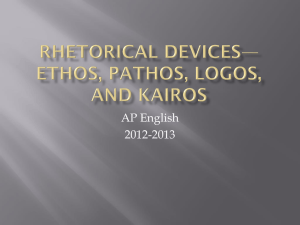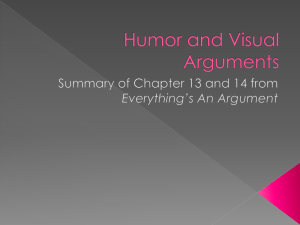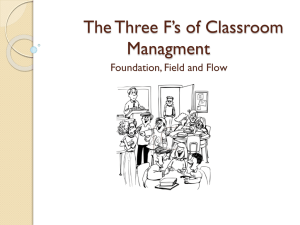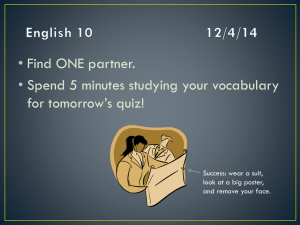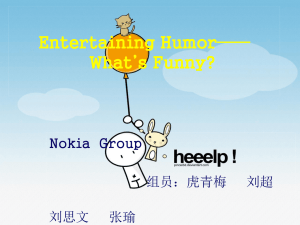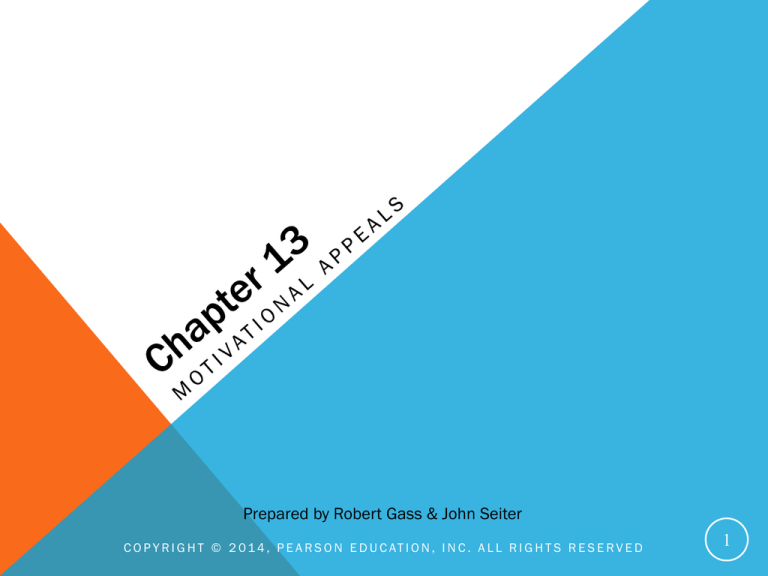
Prepared by Robert Gass & John Seiter
C O P Y R I G H T © 2 01 4 , P E A R S O N E D U C AT I O N , I N C . A L L R I G H T S R E S E R V E D
1
TYPES OF MOTIVATIONAL APPEALS
fear
guilt
pity
sympathy
loyalty
generosity
devotion
kindness
maliciousness
compassion
dedication
patriotism
pride
honor
sex
love
hope
duty
Note: these are only some of the wide variety of appeals used by
persuaders
C O P Y R I G H T © 2 01 4 , P E A R S O N E D U C AT I O N , I N C . A L L R I G H T S R E S E R V E D
2
WHAT ARE MOTIVATIONAL APPEALS?
Definition: "external inducements, often of an emotional
nature, which are designed to increase an individual's
drive to undertake some course of action" (Gass & Seiter,
20114
Intrinsic motivation: an internal desire or drive
Extrinsic motivation: an external incentive or disincentive
May be positive, prosocial or negative, antisocial
May be activating, energizing, or calming, soothing
C O P Y R I G H T © 2 01 4 , P E A R S O N E D U C AT I O N , I N C . A L L R I G H T S R E S E R V E D
3
EMOTIONAL MARKETING
Attachment theory
People develop emotional attachments to specific
brands
They are fiercely loyal to those brands
Examples: Apple, Gibson guitars, Dunkin’ Donuts
Consumers connect with brands on an emotional
level
The brand becomes an extension of the self
Example: A person who drives an electric car may
imbue the brand with his/her eco-mindedness
C O P Y R I G H T © 2 01 4 , P E A R S O N E D U C AT I O N , I N C . A L L R I G H T S R E S E R V E D
4
LOGICAL VERSUS EMOTIONAL APPEALS: A
FALSE DICHOTOMY
Aristotelian typology
Ethos is based on source credibility.
Logos is based on logic and reasoning.
Pathos is based on emotion.
People aren’t strictly rational.
When people agree with the conclusion, they
tend to think a persuasive message is “rational.”
when they disagree with the conclusion, they
tend to think a persuasive message is
“emotional.”
C O P Y R I G H T © 2 01 4 , P E A R S O N E D U C AT I O N , I N C . A L L R I G H T S R E S E R V E D
5
FEAR LEVEL OR INTENSITY
Misleading early research
Janis & Feshbach (1953) claimed
there was a curvilinear relationship
(inverted U) for fear level and
persuasion
The study had serious flaws,
however
More recent findings
Most studies, especially recent
studies, have shown a positive,
linear relationship between fear
level and persuasion
C O P Y R I G H T © 2 01 4 , P E A R S O N E D U C AT I O N , I N C . A L L R I G H T S R E S E R V E D
6
FEAR APPEAL POSTERS FROM WWII
World War II posters instilled fear about sharing military secrets.
C O P Y R I G H T © 2 01 4 , P E A R S O N E D U C AT I O N , I N C . A L L R I G H T S R E S E R V E D
7
WITT’S EXTENDED PARALLEL PROCESSING MODEL
(EPPM)
danger control
The receiver concentrates on ways of reducing the danger
fear control
The receiver focuses on fear itself, and becomes anxious, panicky.
Effective fear appeals trigger danger control, rather than fear control
perceived efficacy
The recommended action is perceived as both effective and feasible to
avoid the danger
response efficacy: “It will work.”
self efficacy: “I can do this.”
C O P Y R I G H T © 2 01 4 , P E A R S O N E D U C AT I O N , I N C . A L L R I G H T S R E S E R V E D
8
KEYS TO USING FEAR APPEALS EFFECTIVELY
Increasing fear intensity is effective, but only if danger
control is operating
Increasing involvement and central processing facilitates
danger control
Triggering fear control will lead to maladaptive responses
Flight, panic, “deer in the headlights”
Provide specific recommendations
What must be done to avoid the harmful consequences?
Emphasize the efficacious nature of the
recommendations
Response efficacy
Self efficacy
C O P Y R I G H T © 2 01 4 , P E A R S O N E D U C AT I O N , I N C . A L L R I G H T S R E S E R V E D
9
SAMPLE PITY PLOYS
Feed the Children
People for the Ethical Treatment of
Animals (PETA)
Muscular Dystrophy telethon
Disaster relief efforts
C O P Y R I G H T © 2 01 4 , P E A R S O N E D U C AT I O N , I N C . A L L R I G H T S R E S E R V E D
10
PITY PLOYS
Dilemma: is it possible to engage in fundraising without
appealing to pity?
negative (helpless victims) portrayals may increase
willingness to donate money
positive portrayals (heroic survivors) may increase
willingness to donate time
Controllability: pity is most effective when the sufferer is
perceived as having no control over his/her situation
C O P Y R I G H T © 2 01 4 , P E A R S O N E D U C AT I O N , I N C . A L L R I G H T S R E S E R V E D
11
PITY PLOYS
Which homeless
person would you be
most likely to give
money to?
Why?
C O P Y R I G H T © 2 01 4 , P E A R S O N E D U C AT I O N , I N C . A L L R I G H T S R E S E R V E D
12
GUILT TRIPS
Appeals to guilt
familial guilt
religious concepts of guilt
PBS pledge drives
funeral home persuasion
belated birthday cards
Guilt appeals can facilitate
compliance.
Guilt appeals work whether
the requester is the source
of guilt or not.
Inducing too much guilt may
lead to avoidance.
Guilt can also breed
resentment
C O P Y R I G H T © 2 01 4 , P E A R S O N E D U C AT I O N , I N C . A L L R I G H T S R E S E R V E D
13
HUMOROUS APPEALS
Humor is prevalent in
advertising
Humor may function as a
distraction
1 in 5 commercials uses humor
Smiling or laughing disrupts
cognitive processing
Roughly 1 in 3 advertisements
uses humor
Humor functions as a peripheral
cue
Humor captures attention
Humor breaks through media
clutter
The distraction inhibits counterarguing
Humor functions as social proof
Laughter can be contagious
Humor increases liking.
A brand seems fun, friendly
C O P Y R I G H T © 2 01 4 , P E A R S O N E D U C AT I O N , I N C . A L L R I G H T S R E S E R V E D
14
HUMOR
Related humor tends to be more
effective than unrelated humor.
Humor should be integrated
into the content of a message
Humor enhances perceptions of
trustworthiness
social attractiveness
Humor may diminish perceived
expertise
The persuader may not appear
to take the issue seriously
Self-disparaging humor can
improve credibility
Not taking one’s self too
seriously
communication competence
C O P Y R I G H T © 2 01 4 , P E A R S O N E D U C AT I O N , I N C . A L L R I G H T S R E S E R V E D
15
PRIDE AND PATRIOTISM
Flag waving works
“Buy American” campaigns
Political candidates “wrap
themselves in the flag”
Presidents’ Day sales
“United We Stand” bumper stickers
Caveats
Pandering to patriotism may
backfire
C O P Y R I G H T © 2 01 4 , P E A R S O N E D U C AT I O N , I N C . A L L R I G H T S R E S E R V E D
16
SEX SELLS!
Sex appeals have long been
part of advertising
In 1983, 15% of print ads used
sex appeals
Objectification theory
Females are more likely to be
viewed as objects or things
Objectification casts females
into passive, submissive roles
In 2003, 27% of print ads used
Males are increasingly being
sex appeals (Pappas, 2012)
objectified as well.
Sex in the City
The Cougar
Desperate Housewives
Images courtesy of Shannanigan.com
http://www.shannanigan.com/
C O P Y R I G H T © 2 01 4 , P E A R S O N E D U C AT I O N , I N C . A L L R I G H T S R E S E R V E D
17
HOW SEX APPEALS FUNCTION
Sex appeals serve as
peripheral cues
There are limitations to
using sex appeals
vicarious experience of
sexuality
resentment
Sex appeals use“ post hoc“
reasoning
distraction
If you use product X you
will be more sexy
If you use product X, other
sexy people will be
attracted to you
backlash
Self objectification
Females may internalize
their status as sex objects
The result is lower esteem,
eating disorders, body
dissatisfaction
C O P Y R I G H T © 2 01 4 , P E A R S O N E D U C AT I O N , I N C . A L L R I G H T S R E S E R V E D
18
WARMTH APPEALS
Aaker & Stayman (1990): 1 in 5 prime-time
commercials include warmth
State Farm, "Like a good neighbor..."
"Poppin' Fresh," the Pillsbury Doughboy
Snuggles fabric softener
Olive Garden, “When you’re here, you’re
family.”
real-estate terminology
rustic
cozy
charming
C O P Y R I G H T © 2 01 4 , P E A R S O N E D U C AT I O N , I N C . A L L R I G H T S R E S E R V E D
19
HOW DO WARMTH APPEALS WORK?
association: manufacturing favorable images and
lifestyles
Wal-Mart greeters make shoppers feel welcome
Snuggles fabric softener bear is cute, cuddly
“Poppin’ Fresh” the Pillsbury Doughboy
contrast effect: interspersing warm ads with other
kinds of ads (serious, humorous, etc) is more
effective
C O P Y R I G H T © 2 01 4 , P E A R S O N E D U C AT I O N , I N C . A L L R I G H T S R E S E R V E D
20
WARMTH IN FACE TO FACE COMPLIANCE GAINING
Sales
car sales (calling customer by first name,
establishing rapport)
food-servers (smiling, introducing oneself by
name, touch)
smiley faces on receipts
Immediacy behaviors
hugging
smiling
nodding approval
pat on the back
C O P Y R I G H T © 2 01 4 , P E A R S O N E D U C AT I O N , I N C . A L L R I G H T S R E S E R V E D
21
INGRATIATION
Types of Ingratiatory Behavior
other enhancement: paying compliments,
engaging in flattery
the 3rd party strategy: “Gus said you are his
favorite teacher!”
opinion conformity: agreeing with another's
opinions and statements
initially disagree, then yield, strategy: “Now that I
think about it, you’re right.”
self-presentation: self-promotion, bragging or selfaggrandizement
example: "I wish I could play golf with you, but I'm
helping at the homeless shelter this weekend."
C O P Y R I G H T © 2 01 4 , P E A R S O N E D U C AT I O N , I N C . A L L R I G H T S R E S E R V E D
22
HOW DOES INGRATIATION WORK?
Liking: ingratiatory behavior tends to increase
liking, attraction
Similarity: ingratiatory behavior tends to increase
perceptions of similarity, perceived commonality
Social Labeling: the target tends to “live up to” the
positive label bestowed on him/her
C O P Y R I G H T © 2 01 4 , P E A R S O N E D U C AT I O N , I N C . A L L R I G H T S R E S E R V E D
23
TECHNIQUES FOR EFFECTIVE INGRATIATION
Brown-Nosing 101
Make the praise credible
Praise an attribute about which the target is insecure
Be discerning; notice things about people
Make sure the praise is not merely seen as normative
Avoid the negative effects of praise
C O P Y R I G H T © 2 01 4 , P E A R S O N E D U C AT I O N , I N C . A L L R I G H T S R E S E R V E D
24
COMBINING MOTIVATIONAL APPEALS
good cop/ bad cop
threat + promise
guilt + pity
sex + pity (Penthouse and PETA ads)
C O P Y R I G H T © 2 01 4 , P E A R S O N E D U C AT I O N , I N C . A L L R I G H T S R E S E R V E D
25

